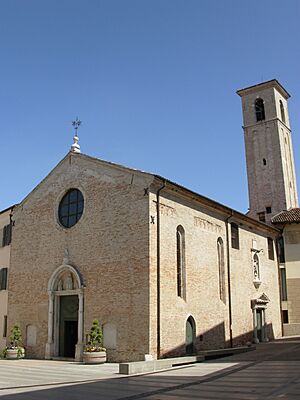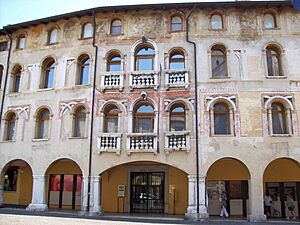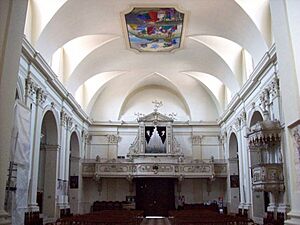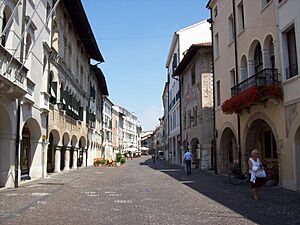Pordenone facts for kids
Quick facts for kids
Pordenone
Pordenon (Venetian, Friulian)
|
|||
|---|---|---|---|
| Comune di Pordenone | |||

Pordenone City Hall and bell tower
|
|||
|
|||
| Country | Italy | ||
| Region | Friuli-Venezia Giulia | ||
| Province | Pordenone | ||
| Frazioni | Borgomeduna, Rorai Grande, San Gregorio, Torre, Vallenoncello, Villanova di Pordenone | ||
| Area | |||
| • Total | 38.2 km2 (14.7 sq mi) | ||
| Elevation | 24 m (79 ft) | ||
| Population
(31 December 2014)
|
|||
| • Total | 51,632 | ||
| • Density | 1,351.6/km2 (3,501/sq mi) | ||
| Demonym(s) | Pordenonesi | ||
| Time zone | UTC+1 (CET) | ||
| • Summer (DST) | UTC+2 (CEST) | ||
| Postal code |
33170
|
||
| Dialing code | 0434 | ||
| Patron saint | Saint Mark | ||
| Saint day | April 25 | ||
Pordenone is a city and a comune (municipality) in the Italian region of Friuli-Venezia Giulia. It is the main city of the Regional decentralization entity of Pordenone.
The name Pordenone comes from Latin Portus Naonis. This means "port on the Noncello River".
Contents
History of Pordenone
Pordenone started in the early Middle Ages as a river port. It was built on the Noncello river and called Portus Naonis. Even before that, during the Roman age, there were already farms and villas in the area, especially near the town of Torre.
Early Rulers and Growth
Between 1257 and 1270, Ottokar II of Bohemia took control of Pordenone. But he was defeated in 1277. The city then returned to the Empire, under Rodolph I of Habsburg.
In 1278, the city was given to the Habsburg family. This made Pordenone an Austrian area inside the land of Friuli. In the 1300s, Pordenone grew a lot because of busy river trade. It officially became a city in December 1314.
Venetian Rule and Changes
In 1508, the city was taken by Venice. This happened after Emperor Maximilian failed to invade Venice. Even though Austria briefly took it back during the War of the League of Cambrai (1509–16), Venice kept control of Pordenone from 1516.
Until 1537, the d'Alviano family ruled the town. This was a reward for Bartolomeo d'Alviano's military help to Venice. Under Venetian rule, a new port was built, and factories got better.
Modern Times and Industry
After the wars led by Napoleon, Pordenone became part of Austria's lands in Italy. A railway connection was built in 1855. Also, the Pontebbana road was constructed. These changes made the port less important. However, they helped industries grow, especially cotton factories. Pordenone became part of Italy in 1866.
The cotton industry faced problems after World War I. It completely failed after the 1929 economic crisis. After World War II, the local Zanussi company became a huge maker of home appliances. In 1968, Pordenone became the main city of its own province. This new province included land that used to belong to Udine.
After World War II, Pordenone became home to many military groups. This was to prevent an invasion from socialist Yugoslavia to the east. This strong military presence helped the local economy grow. Today, Pordenone is home to the 132nd Armored Brigade "Ariete".
Geography and Climate
Pordenone is located in the lowlands of the Po-Venetian Valley. This is south of the Venetian Prealps and the Alpine foothills of Friuli. The lowlands around Pordenone have a lot of water. They are also known for a special "resurgence" event. This is where underground rivers come back to the surface.
Climate in Pordenone
The climate here has small differences between high and low temperatures. There is also enough rainfall all year. This type of weather is called "Humid Subtropical Climate".
| Climate data for Pordenone | |||||||||||||
|---|---|---|---|---|---|---|---|---|---|---|---|---|---|
| Month | Jan | Feb | Mar | Apr | May | Jun | Jul | Aug | Sep | Oct | Nov | Dec | Year |
| Mean daily maximum °C (°F) | 7 (44) |
2 (36) |
12 (53) |
17 (62) |
21 (69) |
25 (77) |
28 (82) |
27 (80) |
24 (75) |
18 (64) |
12 (53) |
8 (46) |
17 (62) |
| Mean daily minimum °C (°F) | −1 (30) |
0 (32) |
2 (35) |
6 (42) |
11 (51) |
14 (57) |
16 (60) |
16 (60) |
13 (55) |
8 (46) |
3 (37) |
0 (32) |
7 (44) |
| Average precipitation mm (inches) | 71 (2.8) |
84 (3.3) |
110 (4.3) |
160 (6.3) |
110 (4.3) |
140 (5.6) |
110 (4.3) |
110 (4.2) |
100 (4.1) |
130 (5.2) |
210 (8.4) |
140 (5.6) |
1,480 (58.4) |
| Source: Weatherbase | |||||||||||||
People and Languages
Local Languages
Long ago, people in Pordenone spoke the Friulian language. But when Venice ruled, the Venetian language became common. This language is more like modern Italian. It developed into the Pordenone dialect spoken today. The towns around Pordenone still speak Friulian.
The Friulian language is protected in Pordenone by a special law from 2007. This law helps to keep the language alive and used.
People from Other Countries
There are 7,025 people from other countries living in Pordenone. This makes up about 13.7% of the city's population. Here are the ten largest groups:
 Romania, 1,810
Romania, 1,810 Albania, 931
Albania, 931 Ghana, 823
Ghana, 823 Bangladesh, 346
Bangladesh, 346 Ukraine, 317
Ukraine, 317 Morocco, 268
Morocco, 268 Moldova, 230
Moldova, 230 People's Republic of China, 229
People's Republic of China, 229 Pakistan, 211
Pakistan, 211 Kosovo, 137
Kosovo, 137
Famous Landmarks
Pordenone has many beautiful old buildings and palaces. Many of them are along the old "Greater Contrada," which is now called Corso Vittorio Emanuele II. This street has lovely Venetian-style arches.
Churches and Religious Sites
- Cathedral of St. Mark (Duomo): This church was built starting in 1363. It mixes Romanesque and Gothic styles. Inside, you can see a famous painting by a local artist called Il Pordenone. It also has a tall bell tower, about 79 meters (259 feet) high.
- Church of St. Mary of the Angels: Built in 1309, this church has a special entrance made of Istrian stone. Inside, there's a crucifix from 1466 and old frescoes.
- Parish Church of San George: This church has a neoclassical style. Its bell tower, built in the 1800s, has Doric columns.
- Church of the Santissima Trinità (Holy Trinity): This church is next to the Noncello river. It has an eight-sided shape and frescoes by Giovanni Maria Calderari.
- Church of Blessed Odoric of Pordenone: This modern church was designed by architect Mario Botta and built in the early 1990s.
- Church of S. Ulderico: Located in the Villanova area, this church has frescoes by Il Pordenone.
- Parish Church of St. Lawrence Martyr: In Roraigrande, this church has a baptismal font by Renaissance sculptors. It also has frescoes by Giovanni Antonio de 'Sacchis'.
Palaces and Historic Buildings
- The Gothic Communal Palace: This city hall was built between 1291 and 1395. A clock-tower was added in the 1500s.
- Palazzo Ricchieri: Built in the 1200s as a strong house with a tower. It now holds the Civic Art Museum.
- Palazzo Polacco – Barbarich – Scaramuzza.
- Palazzo Rorario – Spelladi – Silvestri: This building is home to the municipal art gallery "Harry Bertoia".
- Palazzo Mantica – Cattaneo.
- Palazzo Mantica.
- Palazzo Gregoris.
- Casa Gregoris – Bassani.
- Palazzo Varmo – Pomo: Also known as the House of the Captains.
- Palazzo Crescendolo – Milani.
- Palazzo Popaite – Torriani – Policreti.
- Casa Simoni.
- Casa Pittini.
- Palazzo Domenichini – Varaschini.
- Palazzo Rosittis.
- Palazzo De Rubeis.
Castles and Ancient Sites
- Castello di Torre: This castle from the late 1100s was once home to the Ragogna family. Now it's the Western Friuli Archaeological Museum. It was attacked and destroyed in 1402, but a tower was rebuilt later.
- Castle of the ancient town of Pordenone: Located in Piazza della Motta, this old castle is now a prison.
- Roman Villa of Torre: These are the remains of a fancy Roman villa. They were found in the 1950s.
Venetian Villas
Pordenone has nine buildings that are protected as Venetian Villas.
- Villa Cattaneo, the Gaspera: From the 1600s, it has a tall arched front.
- Villa Cattaneo, Cirielli Barbini: Likely built in the 1700s.
Industrial History Sites
Pordenone also has old factory buildings from the 1800s. These are examples of "industrial archaeology," showing how industries used to look.
Getting Around Pordenone
Roads
The main roads that serve Pordenone are the Autostrada A28 highway and the Strada statale 13 Pontebbana (SS13).
Buses
The local bus company is called ATAP. It has ten "urban routes" that serve the city and nearby areas. It also has many "extraurban routes" that cover the whole Pordenone province. About twenty of these routes connect Pordenone directly to other places, like Aviano, the Venice International Airport, and Lignano Sabbiadoro.
Trains
Pordenone railway station opened in 1855. It is on the Venice–Udine railway line. About 3 million passengers use this station every year.
Airports
The closest airports are Monfalcone-Trieste and Venice-Treviso (TSF) Airport. They are about 75 kilometers (47 miles) away from Pordenone.
Education in Pordenone
Pordenone has many schools for different ages. There are nine kindergartens, twelve primary schools, and four middle schools. For older students, there's the Flora Professional School (for business, cooking, and social services) and the Zanussi Professional School (for industry and crafts). There are also high schools like Matiussi High School of Economics, and two Schools of Technologies (J.F. Kennedy and Pertini). The licei (grammar schools) are Grigoletti Scientific High School and Leopardi-Majorana High School of Classics and Science. Pordenone also has some private schools.
Pordenone has a branch of the University of Trieste. Here, students can study Production Engineering and Management. They can even get a double degree with a German university. The University of Udine also offers courses here, like Multimedial Sciences & Technologies, Nursing, and Multimedia Communication and IT. The university building on Via Prasecco was designed by a Japanese architect named Toyo Ito.
Sports in Pordenone
Pordenone is home to the Ottavio Bottecchia Stadium. This stadium has 3,000 seats. It used to be a soccer field for the local team, Pordenone Calcio. Now, the team plays at another stadium. The Ottavio Bottecchia Stadium is still used as a velodrome for track cycling races. In 2001, it hosted a round of the UCI Track Cycling World Cup. It is known as one of the most important outdoor velodromes in the world. The stadium also has tennis courts and an athletics field.
Reggie Jackson, a famous NBA basketball player, was born in Pordenone.
Since 1983, Pordenone has hosted the Volleyball Cornacchia World Cup. This is a competition for young players (U19 / U17 for boys and girls).
Culture and Arts
Literature
Every year for over ten years, Pordenone has hosted the pordenonelegge.it book festival. During this event, book stalls are set up all over the city center. There are also interviews with Italian and international authors, and talks by journalists and experts.
Film
Pordenone has been the main host of the Le Giornate del cinema muto since 1981. This festival celebrates silent films. It moved to Sacile for eight years while its main theater was being rebuilt.
Pordenone also hosts the FMK International Short Film Festival.
Music
In the 1980s, Pordenone was a major center for punk rock music in Italy.
The punk-rock band Prozac+ and the alternative rock band Tre Allegri Ragazzi Morti started in Pordenone in the 1990s. The Reggae band Mellow Mood also formed here in 2005.
Since 1991, the city has hosted the Pordenone Blues Festival every summer. Since 2010, this festival also includes performing arts, literature, and visual arts. Famous guests have included Kool & the Gang, Steve Hackett, and Anastacia. Artists from many countries perform at this festival.
Museums and Galleries
- Diocesan Museum of Sacred Art – Diocese of Concordia-Pordenone: This museum has many beautiful artworks from churches and religious buildings in the area.
- Town Art Museum: Located in the Palazzo Ricchieri, this museum helps you understand the art of Veneto and Friuli-Venezia Giulia. It has works by famous painters like Pordenone and Tintoretto.
- Archaeological Museum of Western Friuli: Since 2006, this museum has been in the old castle of Torre. It shows archaeological finds from the province of Pordenone. Important items include finds from caves and ancient stilt houses (which are a UNESCO World Heritage Site).
- Gallery of Modern and Contemporary Art "Armando Pizzinato": This museum is in a Venetian villa in the city park. It has paintings by artists like Mario Sironi and Renato Guttuso.
Newspapers
Two Italian daily newspapers have a local edition for Pordenone:
- Messaggero Veneto – Giornale del Friuli
- Il Gazzettino
Tourism in Pordenone
Pordenone is a great starting point to explore the province of Pordenone and its many sights. Pordenone Turismo provides lots of information for visitors. Since 2022, the Pordenone Greeters offer free tours for guests. This group is part of the international Greeter network.
Sister Cities
Pordenone is connected with other cities around the world. These are called "sister cities" or "twin towns."
 Spittal an der Drau, Austria, since 1987
Spittal an der Drau, Austria, since 1987 San Martín, Argentina, since 2003
San Martín, Argentina, since 2003 Irkutsk, Russia, since 2005
Irkutsk, Russia, since 2005 Ōkawa, Japan
Ōkawa, Japan
Notable People from Pordenone
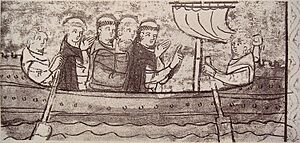
- Odoric of Pordenone (1286–1331), a Franciscan friar and explorer from the late Middle Ages.
- Il Pordenone (around 1484–1539), real name Giovanni Antonio de’ Sacchis, a Mannerist painter.
- Hieronymus Rorarius (1485–1556), an envoy for Charles V and a papal nuncio.
- Giovanni Maria Zaffoni (around 1500 – after 1570), a Renaissance painter.
- Pomponio Amalteo (1505–1588), a painter from the Venetian school.
- Girolamo Michelangelo Grigoletti (1801–1870), a Neoclassical painter.
- Rudy Buttignol (born 1951), a Canadian television executive.
- Davide Toffolo (born 1965), a comic book author.
- Raffaello D'Andrea (born 1967), a robotics engineer.
Sports Personalities
- Stefano Lombardi (born 1976), an Italian footballer.
- Luca Rossetti (born 1976), an Italian rally driver.
- Marzia Caravelli (born 1981), an Italian hurdler who competed in two Olympics.
- Daniele Molmenti (born 1984), an Italian slalom canoeist.
- Federico Gerardi (born 1987), an Italian footballer.
- Reggie Jackson (born 1990), an American professional basketball player.
- Nicola de Marco (born 1990), an Italian racing driver.
- Alessia Trost (born 1993), an Italian Olympic high jumper.
- Ivan Provedel (born 1994), a professional football goalkeeper.
See also
 In Spanish: Pordenone para niños
In Spanish: Pordenone para niños




